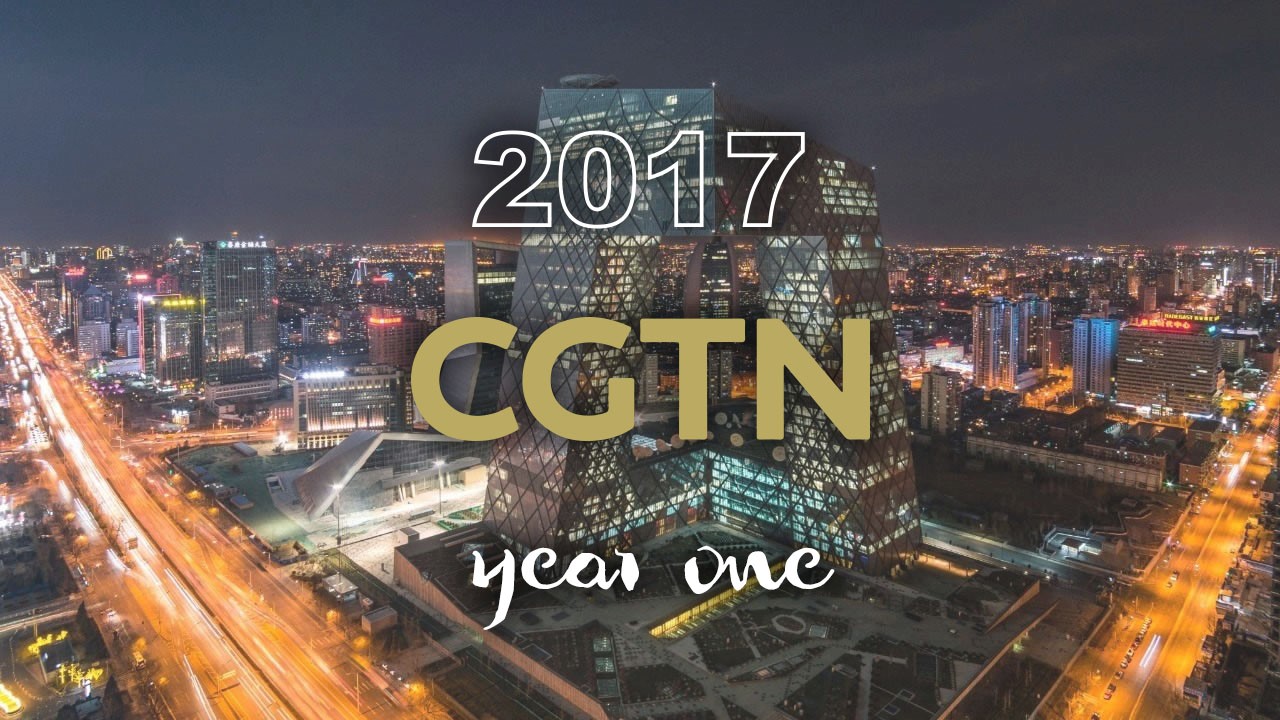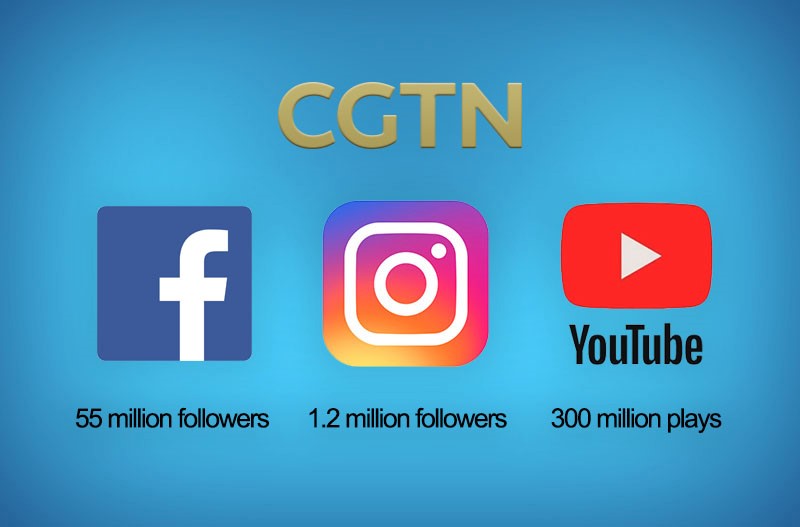CGTN in 2017
by CGTN Controller Jiang Heping
Jan 01, 2018
Following the launch of China Global Television Network (CGTN) on 31 December 2016, Chinese President Xi Jinping stated in a congratulatory letter that CGTN should “be culturally confident, news-focused, audience-aware, and use integrated media and ample news sources to spread the stories and voices of China with a clear-cut Chinese perspective and a broad global vision.” With the merger of CGTN and the multi-language CCTVNEWS channels, which became a multi-language and multi-platform flagship media group for Chinese publicity, CGTN's development in 2017 epitomizes the words of President Xi in his 2018 New Year’s speech: “Fortune favors the diligent and the world changes its appearance every second.”

With President Xi’s important words in mind, we made a steady start in our first year of operation (2017), implementing innovations and achieving breakthroughs and early-stage influence, which laid a solid foundation for creating a main Chinese publicity group with prominent international influence.
Firstly, with the introduction of broadcasts, CGTN’s multi-language channels underwent program revisions, channel packaging, safe broadcasting, and studio launching as expected, and were subsequently recognized by both domestic and international media industries and audiences. Furthermore, our six channels, namely CGTN English, Spanish, French, Arabic, Russian, and Documentary, were rebranded with a new color scheme of blue and champagne gold. We produced eighteen new programs while upgrading and revising existing programs, all of which reinforced our international media image.
Using a high-standard studio, CGTN English released eight new programs: “The World Today,” “Global Watch,” “The Link,” “The Point,” “China 24” (U.S. edition), “Global Business” (U.S. edition), “Rediscovering China,” and “Big Story”. Meanwhile, CGTN Spanish, French, Arabic, and Russian broadcasted new programs, namely “Weekend Topics,” “In-Depth Report,” and “Weekly Connection with World,” while dubbing and broadcasting TV plays in their respective languages. Multiple interview programs, including CGTN English’s “Dialogue,” “World Insight,” and “The Point,” CGTN America’s “The Heat,” and CGTN Africa’s “Faces of Africa” developed firmer Chinese perspectives.
CGTN made efforts to increase intensity and sharpness of its comments, with multiple interview programs showing clear Chinese perspectives and viewpoints. Relevant programs included "Dialogue", "World Insight" and "The Point" which are broadcast on CGTN English, "The Heat" on CGTN America and "Faces of Africa" on CGTN Africa.

The “Dialogue” team in specific organized the following activities: a “Dialogue with Thinkers,” a discussion panel at the Boao Forum for Asia (BFA) Annual Conference held in March 2017; a “Dialogue of Civilizations” in October at the 2017 Rhodes Forum in Greece, and a sub-forum for dialogue for young military officers at the Xiangshan Forum.
The “World Insight” team jointly produced a special program called “Globalization and Global Economy” with NBC News of the United States at the St. Petersburg International Economic Forum (SPIEF) 2017, where the team also hosted an exclusive interview with United Nations Secretary-General António Guterres, therefore becoming the first Chinese media to do so after he took office.
At the 2017 BRICS summit in Xiamen, China, CGTN invited four other TV stations from other BRICS countries (Brazil, Russia, India, China, and South Africa) to co-host a special program of “The Point” in Beijing. The program was simultaneously broadcast in all five BRICS countries, and was well received by Chinese Ambassador to the United States Cui Tiankai, who spoke highly of the program during a special phone call. “The Point” also held several “roundtable forums,” where relevant guests from home and abroad gathered to exchange viewpoints in person. Amid reports of a standoff between the border troops of China and India in 2017, a video from the show acquitting an Indian military officer was watched over 100 million times globally. The host of “The Point,” Liu Xin, attracted 1.37 million new followers on Facebook after rebutting a BBC journalist on improper and false reports about the 19th National Congress of the Communist Party of China (CPC) in October 2017.
CGTN carefully planned and arranged the coverage of all major events in 2017: high-level visits by President Xi Jinping, the annual sessions of the National People's Congress (NPC) and Chinese People's Political Consultative Conference (CPPCC), the Boao Forum for Asia Annual Conference, the Belt and Road Forum for International Cooperation, the 20th anniversary of Hong Kong's return to the motherland, the military parade marking the 90th anniversary of the founding of the People's Liberation Army (PLA), the BRICS Xiamen Summit, and the 19th CPC National Congress.
For the first time, CGTN sent foreign journalists to cover the two sessions of the NPC and CPPCC, where Chinese Foreign Minister Wang Yi praised and wished for CGTN’s fast development while taking questions from our host, Tian Wei. That was also the first question from CGTN at the two sessions.
We made innovations in aims, angles, forms and ways while covering the 19th CPC National Congress. Our reports fully reflected the "openness" of the congress and its "relatedness" to the world and people. Also for the first time, we adopted a reporting mode featuring “live reporters in China, America, and Africa broadcasting at the same time on the same footage”. In total, CGTN journalists asked three questions at relevant press conferences. Before the Congress, CGTN broke the previous record by carrying out a 42-day warm-up report, featuring a marathon broadcast of the 15-episode-long “China Footprint” and 27-episode-long “The Big Picture” to convey China’s confidence and positive energy in its development to the world. The live broadcast signal of our special program on members of the Standing Committee of the Political Bureau of the 19th CPC Central Committee meeting the press was used by international media organizations including CNN, BBC and Channel NewsAsia in Singapore.
CGTN also made breakthroughs in reports of political news, with our journalists joining special political news teams to cover Chinese leaders' overseas visits, and it has become a normal for us to implement live broadcasts of major political news on new media. For the first time for Chinese media, CGTN had its U.S. journalists from CGTN America come to China with the White House press corps to cover U.S. President Donald Trump's state visit to China in November 2017.
In terms of reporting, CGTN internationalized its storylines and themes, while elaborately planning live broadcast programs on special topics to produce a series of high-quality domestic reports, including “What Is China,” “Decoding the Chinese Economy,” “China's New Growth Drivers,” and “Targeted Poverty Reduction”.
Throughout the year, our international reports have grown increasingly exclusive as well. For example, CGTN’s private interview with the newly-elected Gambian president, Adama Barrow, while reporting on the country's competitive election was cited by many international media organizations who could not interview Mr. Barrow themselves. Reports such as those on the sixth anniversary of the Syrian War and other war-torn countries like Mosul and Ukraine manifest our international vision. In fact, the CGTN reporter covering the Mosul operation became the first international journalist to enter the core zone. CGTN Africa sent more than 10 journalists to cover famine across the continent, releasing stories from seven African countries and regions that were blind spots in reports by Western media.
In addition to its internalization, CGTN also deepened its localization of program productions. More specifically, CGTN English extended its daily broadcast time of CGTN America programs from 5 hours to 6, and those from CGTN Africa from 2.5 hours to 3. The channel also introduced a new daily 30-minute program, “China 24” (U.S. edition), while similarly expanding “Global Business” (U.S. edition) to 30 minutes as well. Lastly, our business and national news have adopted a greater focus on Chinese relations with the United States and the rest of the world.
CGTN also further improved its integrated layout of domestic and international reports, with 149 reporters dispatched to nearly 70 countries and regions across the world. Following CGTN English, CGTN Spanish, French, Arabic, and Russian gradually stationed their reporters overseas, along with all-media equipment for live broadcast and news material distribution. By launching English reporting points in September in Zhengzhou, capital city of central China's Henan Province, and Shenyang, capital city of northeast China's Liaoning Province, CGTN enhanced its Beijing-headquartered domestic reporting network, which also covers Shanghai, Guangzhou City, and Chengdu City. Collaborations with colleges and think tanks, including the School of Journalism at Fudan University, helped build a planning mechanism with 2,000 contributors in its international resource pool and 200 regular contributors.
No longer solely relying on its own transmission as done in years past, CGTN shifted the focus of all its multi-language channels to cooperative transmission with overseas media. CGTN English worked with Robert Lawrence Kuhn to present a weekly show, “Closer to China,” and jointly produced “Dialogue with the World” with television stations from Australia, South Korea, India, Germany and Greece. CGTN Spanish worked with Latin America's Telesur to produce “Prisma”. CGTN French co-filmed “New Link for Belt and Road: China-Europe Freight Trains” with the Swiss Broadcasting Corporation, and co-hosted the French Aces competition with TV5Monde. CGTN Arabic alternated with Lebanese state television to host television week. Together with relevant media in Russia and Central Asia, CGTN Russia jointly presented “Time in Eurasia”, and organized a joint trip of journalists to northwest China's Xinjiang Uygur Autonomous Region. In sum, cooperative transmission is now an essential way for CGTN to improve the effect of its international transmission.
Under the principle of television as its main force, while putting mobile first and converging of transmission channels, the top-level design of CGTN is based on the idea of media convergence.
The operation launch of the media convergence center on October 10, 2017 marks an important step forward for CGTN's transmission convergence. Today, the media convergence center combines multi-format news gathering, multi-platform resource sharing, and multi-channel and multi-language distribution outlets. It maximizes resource sharing, enhances unified command and dispatch, and values all-media news material distribution as a rigid assessment index for reporters, thus completely changing the secondary position of new media. Statistics from 2017 shows that CGTN English gathered more than 1,700 domestic new media news stories from its reporters that year, with a growth rate of 50% over the past year.
As social media continued to climb the ranks of the communications industry in the past year, CGTN transitioned to posting higher quality news on its social media platforms while enhancing interactive transmission. As a result, several of its new media followers more than doubled in number, from 47 million upon launch to 95.32 million, while its number of total readers surpassed 11 billion. CGTN's main English account on Facebook boasted more than 54.69 million followers in 2017, making it the world's largest major account for news media. Videos posted on its YouTube account received over 300 million hits, the most among state-run media. CGTN English's main Instagram account accumulated more than 1.2 million followers, once again the most among state-run media.

CGTN Spanish, French, Arabic, and Russian all saw rapid growth in their social media followings in 2017, with the combined total surpassing 25.52 million followers. Alone, CGTN French had over 8 million followers on Facebook, trailing France 24 slightly in follower count. CGTN Arabic too had also over eight million followers on Facebook, making it a mainstream Arabic account globally. CGTN Spanish had 7.4 million followers, while CGTN Russian had 420,000, both the largest Facebook accounts compared to their counterparts in China.
Also on October 10, 2017, CGTN released its upgraded mobile news app, featuring optimized function blocks and enhanced commenting, video-playing and live streaming functions. The new app was downloaded by over 3.91 million users, 95 percent of which were overseas, constituting the same-level user scale as those of earlier launched apps Al Jazeera and Russia Today. The revamped CGTN app posted more than 90 pieces of news materials every day, with its monthly average news publishing more than doubled compared to early 2017, and total page views reaching nearly 54 million.
Launched on December 31, 2016, CGTN embraced a hugely successful first year of operation, gaining widespread attention and recognition from international media circles. In its international news media survey report for the second quarter of 2017, the South Africa-based market research group New World Wealth rated CGTN as the “most neutral international news media,” overtaking other top media outlets including BBC and CNN. The report also selected CGTN's Yang Rui and Tian Wei and three other international hosts as the “most neutral television news program hosts”. Honorable recognition of CGTN’s objective and fair reporting cleared it of any stigmatization from global public opinion. In September 2017, a third-party rating agency of KPMG rated CGTN's social brand among the top 50 of the “China Brands Get Personal, Go Global” list.
CGTN's programs won 28 important domestic and international awards in 2017. The “CGTN Brand Promo: North Africa Edition” won the silver award for “Best News and Current Affairs Promo” at the 2017 PromaxBDA Africa Awards. CGTN English's “Inside Zaatari Refugee Camp” won a Silver World Medal in the “Current Affairs” category at the 2017 New York Festivals International TV and Film Awards, while its “Operation: Drug War” won the Gold Camera award in the “Current Affairs Documentary” category at the 2017 U.S. International Film and Video Festival Award. CGTN Arabic's Second Arabic Language Contest and “Terrorism: Common Enemy of Human Kind” won the Best TV Gala and Best Warning Promo at the 18th Arabic Language Radio and Television Festival, respectively.
After only CGTN’s first year of operation, we are just getting started. With China standing at a historical starting point, CGTN faces a new development era, in which we will develop new steps and advances. As a flagship media group for Chinese publicity, CGTN has the consciousness and courage to improve itself each day and forever build on improvement, while generating more powerful concepts that strive to realize the guidance of the “Chinese mode” in the field of international communication as soon as possible.






